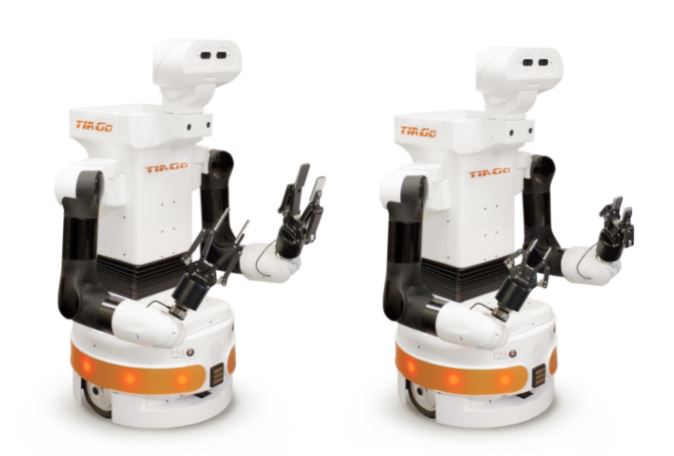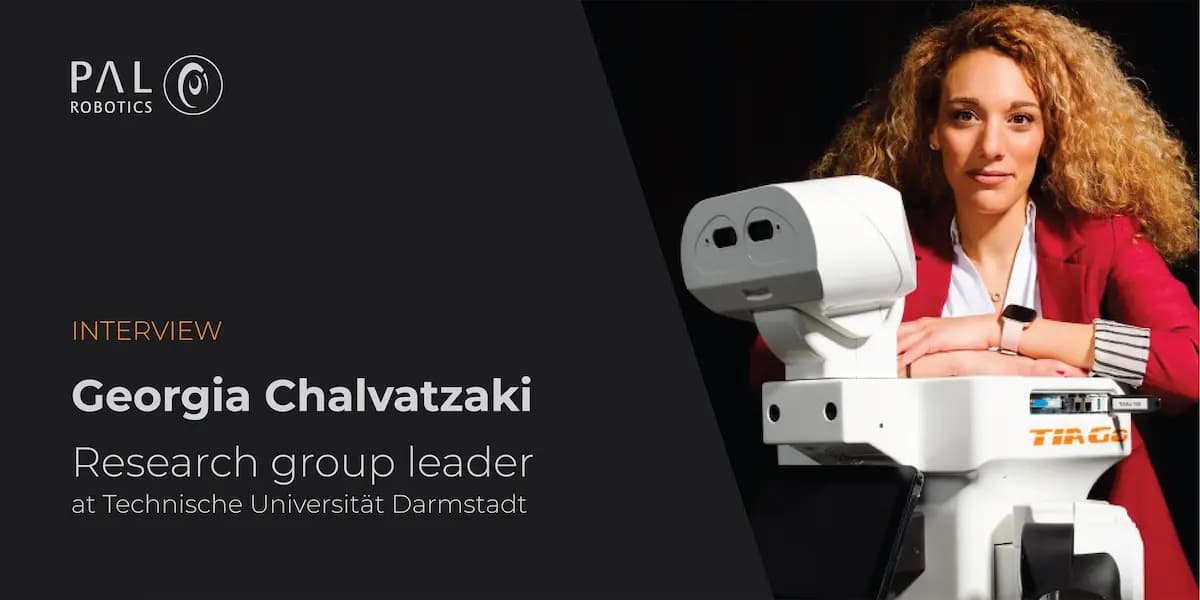Role as a KI-camp AI newcomer and helping to inspire women and young people to choose robotics
Rising star in robotics, Dr. Georgia Chalvatzaki is an independent research group leader of the iROSA group at TU Darmstadt in Germany. Dr. Chalvatzaki was also accepted for the renowned Emmy Noether Programme (ENP) of the German Research Foundation (DFG), which enables outstanding young scientists to qualify for a university professorship by independently leading a junior research group. In part two of our interview, we talk with Georgia on topics such as mobile manipulation, AI, robotic assistants and more, including working with one of her platforms of choice, PAL Robotics’ TIAGo robot.
This is part two of our interview with Georgia, if you missed part one, read here the first part of the interview.
To date, Georgia has worked on eight research projects, and she has published more than 30 papers. Her research interests and expertise include human detection and tracking with applications in the field of assistive robotics. She is also a member of institutions including the IEEE Robotics & Automation Society, IEEE Women in Engineering, and Cybernetics Society.
We asked Georgia about her role as a KI-camp AI newcomer and how she hopes this will aid her research, she said, “this title basically puts you on the spotlight at least in German society, bringing recipients more visibility and in particular for me in the field of AI and robotics. So having received this, one mission for sure from my side is to demonstrate the achievements of women in robotics – leading research team teams and pushing forward research in this challenging area. So, this is one thing that I want to do is deliver on.”
She continued, “and of course, through this title, apart from delivering the message about how I feel my work on robot learning for mobile manipulation can give us more intelligent robotic assistance, I want to engage younger people in this research direction. If we can research it, we can basically work on it to make it happen in the long term. I would be very glad if I can inspire younger people to work in science and engineering.”
Research projects at the iROSA Lab including Skills4Robots, KoBo, RoboTrust, and CHIRON
We asked about EU research projects Georgia works on with the team at the iROSA Lab, including Skills4Robots, KoBo, RoboTrust, and CHIRON, she explained, “in Skills4Robots, I basically focused a lot on the idea of accelerating manipulation, and this was a very important aspect because we need these kinds of algorithms when we have a robot operating in domestic environments when you want it to learn how to execute new tasks that are not pre-programmed from, from scratch.”
She added, “Skills4Robots was the project that introduced me to the first mobile manipulator that I’ve ever worked with. So, although I have worked with humanoid robots and mobile robots and manipulators, I’d never actually worked with a real mobile manipulator.
CHIRON is another research project that again focuses on mobile manipulation, and in particular, on teleoperation deliverability and shared-control, it involves the users of the TIAGo robot and teleoperation abilities – for example, how can you use this information so that a robot can operate in a supermarket to get things for you, but you can still have some kind of perception through the robot and give some feedback on whether the robot has executed the tasks that you want it to do.”
The Technical Committee of Mobile Manipulation and helping enable robots to become personal assistants
Georgia told us more about her membership in the Technical Committee of Mobile Manipulation and how she hopes the committee will help shape the future of robotics, “I joined the Technical Committee just a few months ago, and I was very happy about it. The Technical Committee of Mobile Manipulation has the mission of delivering the message that mobile manipulation is here. Mobile manipulation is one of the few ways I think that we can enable robots to become personal assistants, in our houses, in our hospitals, in residential homes with older people, for example.
This will be the mission that we will try to send to the community to engage them more actively in this research direction. And keep pushing forward with this because, in the past, we focused more separately on manipulation and navigation. However, I think that now we have the tools, we have algorithms, and we can push a bit more forward towards the direction of mobile manipulation.”

The future of robotics and intelligent robotic assistants at home and in healthcare
Georgia gave her opinion on the topic of intelligent robotic assistants for our future, “I think that intelligent robotic assistance that can operate in houses in hospitals is a very, very important milestone that we as researchers should achieve in the near future.”
To conclude, she told us, “an example of a challenge is that the population is aging, and we need to show that older people can be taken care of – the current provision is not enough. So we need robotic assistance to also interact with the older people, not only for delivering things to them but also for keeping them company. So, it is a very important challenge for the future. As well as provoking the opportunity of having robots take on tasks that are very dangerous, in place of humans.”
We would like to thank Dr Georgia Chalvatzaki for taking the time to talk with us. Find out more about the iROSA Laband their work. To learn about the capabilities of TIAGo and the different customizations available visit our website. Finally, if you would like to ask us more about TIAGo as a research platform, do not hesitate to visit our contact page and reach out to us!
TIAGo the mobile manipulator robot, combines perception, navigation, manipulation & Human-Robot Interaction skills out of the box. TIAGo robot has a modular design and can be configured based on customer needs. TIAGo customizations available include TIAGo Titanium, TIAGo Steel, TIAGo Iron, and TIAGo ++, a dual-armed version of the humanoid robot.
TIAGo has interchangeable end effectors, making the robot flexible in adapting to different research needs and use cases. The newest end effectors available for TIAGo are: Gripper 2F-140, and Gripper 2F-85. These end effectors by Robotiq bring versatility to the robot for picking up objects with different types of textures and surfaces. Find out more about those here.
For all our other articles, check out our blog homepage.
